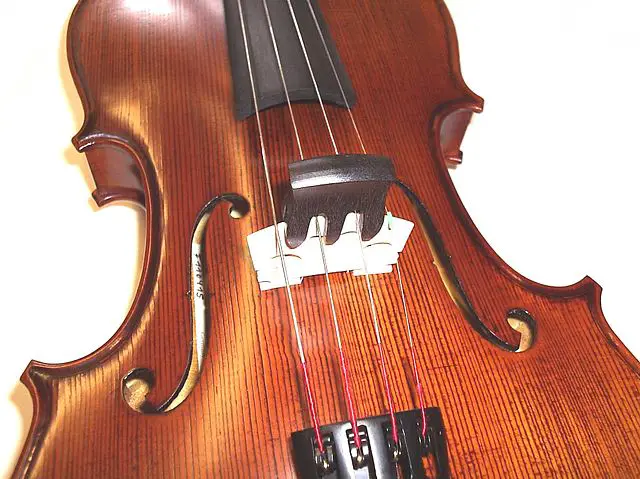Violins, and string instruments in general, often need a few accessories to work well. Picks, supports, covers, and mutes. The first three are self-explanatory, but you might be wondering now; what are violin mutes for?
In the next sections, we’ll explain the function of violin mutes, who needs them, how they work, and the various types of these add-ons.
Summary
Violin mutes are accessories that dim the loudness of a violin and attach to the bridge. The volume of the music can be reduced a bit or all the way down to a whisper. This depends on the type and material of the mute used. Mutes are used in the practice or certain music ensembles.
Table of Contents
What Are Violin Mutes?
Violin mutes are small attachments that allow a player to decrease the audible volume of the music. This is actually a much-needed option while practicing.
Mutes are simply dampers placed on the bridge of a violin to attenuate the vibrations created in the strings. This, in turn, allows a lower-intensity sound wave to reach the body of the violin for amplification.
Some people compare this “quietening” effect to the muted sound of electric violins. There are a few similarities, but the main difference is that the standard acoustic violin rarely reaches the hushed tones of the electric violin.
Violin mutes can decrease the audible volume by around 20-70%. Some more complex mutes could reach a 90% reduction, but that’s not too common. Some orchestral mutes would only reduce around 5-10% and they’re totally in demand.

What Are the Uses of Violin Mutes?
There are two main uses for violin mutes:
- Practicing music quietly and so practicing at all hours.
- Keeping the fiddle as the background in an ensemble, not the hero.
Using Violin Mutes While Practicing
If you live in a large house where you can play your violin all day long and no one would hear you, then, there’s little chance that you’d need a mute. Additionally, if you’re not planning on joining an ensemble, then the chances are lower you’d even come across a mute!
These conditions aren’t too realistic though, as most of us either live with family, roommates, or life partners. Plus, there are all the nice neighbors surrounding our residence.
All these folks could be fully supportive. But repeating the same three tunes a gazillion times while practicing, can drive the most loving audience nuts!
There’s also an added perk to the violin players, and that is not hearing loud tunes for extended periods of time. Even if that’s good music.
Many studies demonstrate that keeping things quiet is beneficial both physiologically and psychollogically.
Practice mutes are often in the 40 to 60% reduction range. However, if a violinist likes practicing in the middle of the night, or very early morning, higher dimming capabilities would be better.
Using Violin Mutes in an Orchestral Setting
A piece where the violin is the hero would say so openly, and the violinist would often sit or stand pretty close to the conductor. That is the front and center of the stage.
This isn’t always the case though, and sometimes, the violin needs to be a background for another instrument to play the solo.
In that case, a violin mute can be effective. This is usually indicated in sheet music as con sordino which is Italian for “with a mute”.If a mute isn’t required for an orchestral piece, that would also be clearly labeled as senza sordino, which means “without a mute”.
The same applies when the sheet music indicates piano or pianissimo, which also means play ever so softly. And that too warrants the use of a violin mute.
Violin mutes for concerts are usually not too intense. The violins should still be heard, but not too much. A 20 to 40% reduction is common in these settings.
The more important factor is to get a mute that doesn’t change the timbre of the violin notes too much. Also, one that fits well and doesn’t move around all the time.
What Does a Violin With a Mute Sound Like?
Typically, the overall sound quality of the violin doesn’t get affected drastically. Using a mute only dims the volume to some extent. In reality, most players notice a change in the timbre of the music.
Interestingly, the detected changes are often favorable. It’s like concentrating the all flavors into one savory bite. Even though it’s a hushed sound, the tunes are soft, mellow, and much less intrusive than a senza sordino violin.
There are some other accounts that relate to a different experience, where the nuances between the tunes become indistinguishable. Pretty much like playing an electric violin, where the articulations and personal touches are mostly lost.
The previous descriptions apply where the mute is well-fitting and made from fine quality materials. Otherwise, there would be interferences, scratches, and other interruptive noises from an unstable mute.
In general, mutes make the violin sound rather ethereal.
How Much Quieter Will a Violin Sound With a Mute?
The commercially available mutes can reduce the sound coming out of a violin by around 70%.
However, more specialized violin mutes can take that figure even further. Some brands reach values as high as 80 or 90%.
These are pretty extreme limits though, and it’s to be expected that quite a bit of the music signal would be lost in the attenuation stage.
How Do Violin Mutes Work?
Violins create sound by sending vibrations from the string through the bridge, the body of the instrument, and the sound post. Sound waves reverberate around the instrument causing the tone to echo and project.
The mute clamps onto the bridge and increases its mass. Therefore it takes more energy to create sound waves through the bridge and the sound is dampened.
Violin mutes have been around for ages, to the point that you’d find them mentioned in orchestral classical music sheets.
They do work quite nicely, especially, when the violinist doesn’t require extremely drastic dimming. This way, the sound quality isn’t affected much, and the neighbors wouldn’t be disturbed at all.
Where Do You Put a Violin Mute?
Violin mutes are typically placed on the bridge. That’s where their dimming effect works best, and that’s where they’re least intrusive.
There are some varieties that can be “parked” behind the bridge until they’re needed. And these are placed on the D-string, or another combination of strings, when not in use.
This temporary placement shouldn’t affect the sound of the violin, rattle, or cause any inconvenience to the player. In such cases, it would be best to look for a different type.
Are Violin Mutes Good?
Nothing in this world is perfect! But, as far as dimming the volume of a violin is needed, then violin mutes are quite effective.
Naturally, buying a prime quality product, aiming for a good fit, and not going overboard with volume reduction gives the best results.
What Are the Different Types of Violin Mute?
Violin mutes are pretty similar in principle, but they have slight design differences that cater to individual requirements. This usually means, does the player need slight muting, moderate muting, or excessive muting?
In some situations, violin players use more than one type of mute as needed for practice and ensemble performance.
One of the most important factors that affect the performance of a violin mute is the material it’s made from. The most common ones are rubber, metal, wire, and leather.
The following are the main types of violin mutes:
These Tourte and Round Tourte mutes are often made from rubber, and they come with a couple of slots that help to park them on the strings behind the bridge.
This is the easiest arrangement that allows the violinist to apply the mute then take it back off repeatedly. When it’s not in use, it just stays put near the tailpiece.
The orchestral mutes, also known as the standard mutes, don’t reduce the violin’s volume too much. Thus, they wouldn’t be too practical for practice.
Metal practice mutes give the highest sound reduction compared to all the other types. So it’s a great option for all the late-night owls or early-morning larks of the music world.
Two things might be a bit off with a metal mute: first, the fit, as it doesn’t sit too well on every type of bridge. And second, the tinny sound. This is a tradeoff many are willing to do though.
This mute is a direct derivative of the orchestral mutes. The main addition is a magnetic clip that attaches to the fingerboard. Generally, it keeps the mute secure in place and minimizes its movement while playing.
- Leather Mute
Leather mutes easily take the shape of the bridge they’re mounted on. They provide moderate sound reduction, and some have the extra option of double positioning. This gives two levels of muting.
They also give an impressive sound quality.
- Rubber Mute
Rubber mutes are probably the most common practice mutes. They aren’t expensive and they really dampen down the sound.
The only snag with these is their bulky size and height.
- Wire Mute
This is a slide-on mute made from an elaborate metal frame. Usually, it contains three brass cylinders covered by a plastic tube.
This is a pretty good mute for home practice, but it comes with two size fits only. It’s suitable for 3/4 and 4/4 violins only.
- Caterpillar Mute
This is an extremely low-profile magnetic mute that fits snugly on any bridge. The variation in bridge curvature, width, or thickness wouldn’t affect the fit. That’s because the caterpillar literally molds itself onto the bridge.
This mute is quite powerful in its dimming capabilities, so it’s good as a practice mute. And the good news is that the sound quality remains superb even with the significant volume reduction.
Conclusion
It’s amazing what a little piece of rubber could allow a violinist to do. This goes from practicing late at night, to participating in orchestral ensembles.
A violin mute is a practical little device that helps in reducing the volume of the music a little or a lot. It all depends on the violinist’s individual needs.
